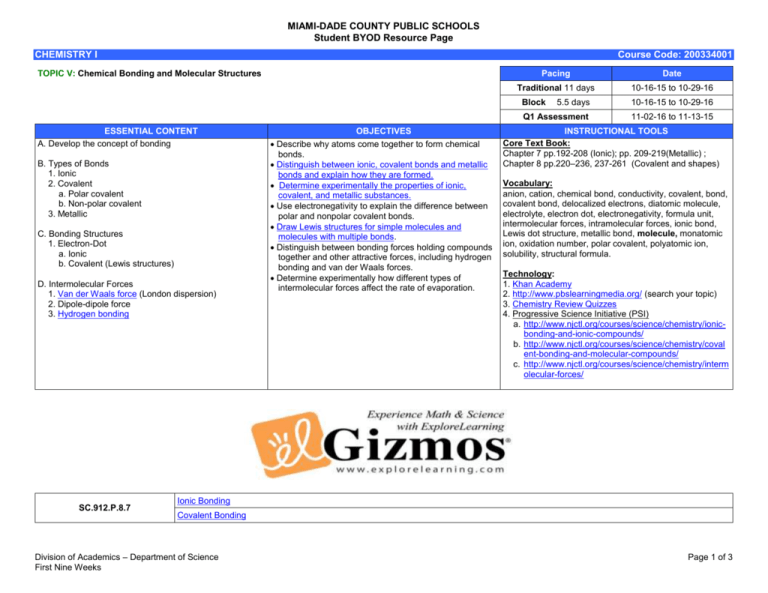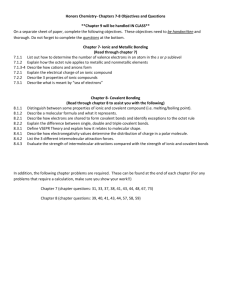Topic V – Chemical Bonding and Molecular Structures
advertisement

MIAMI-DADE COUNTY PUBLIC SCHOOLS Student BYOD Resource Page CHEMISTRY I Course Code: 200334001 TOPIC V: Chemical Bonding and Molecular Structures Pacing Date Traditional 11 days 10-16-15 to 10-29-16 Block ESSENTIAL CONTENT A. Develop the concept of bonding B. Types of Bonds 1. Ionic 2. Covalent a. Polar covalent b. Non-polar covalent 3. Metallic C. Bonding Structures 1. Electron-Dot a. Ionic b. Covalent (Lewis structures) D. Intermolecular Forces 1. Van der Waals force (London dispersion) 2. Dipole-dipole force 3. Hydrogen bonding SC.912.P.8.7 OBJECTIVES Describe why atoms come together to form chemical bonds. Distinguish between ionic, covalent bonds and metallic bonds and explain how they are formed. Determine experimentally the properties of ionic, covalent, and metallic substances. Use electronegativity to explain the difference between polar and nonpolar covalent bonds. Draw Lewis structures for simple molecules and molecules with multiple bonds. Distinguish between bonding forces holding compounds together and other attractive forces, including hydrogen bonding and van der Waals forces. Determine experimentally how different types of intermolecular forces affect the rate of evaporation. 5.5 days 10-16-15 to 10-29-16 Q1 Assessment 11-02-16 to 11-13-15 INSTRUCTIONAL TOOLS Core Text Book: Chapter 7 pp.192-208 (Ionic); pp. 209-219(Metallic) ; Chapter 8 pp.220–236, 237-261 (Covalent and shapes) Vocabulary: anion, cation, chemical bond, conductivity, covalent, bond, covalent bond, delocalized electrons, diatomic molecule, electrolyte, electron dot, electronegativity, formula unit, intermolecular forces, intramolecular forces, ionic bond, Lewis dot structure, metallic bond, molecule, monatomic ion, oxidation number, polar covalent, polyatomic ion, solubility, structural formula. Technology: 1. Khan Academy 2. http://www.pbslearningmedia.org/ (search your topic) 3. Chemistry Review Quizzes 4. Progressive Science Initiative (PSI) a. http://www.njctl.org/courses/science/chemistry/ionicbonding-and-ionic-compounds/ b. http://www.njctl.org/courses/science/chemistry/coval ent-bonding-and-molecular-compounds/ c. http://www.njctl.org/courses/science/chemistry/interm olecular-forces/ Ionic Bonding Covalent Bonding Division of Academics – Department of Science First Nine Weeks Page 1 of 3 MIAMI-DADE COUNTY PUBLIC SCHOOLS Student BYOD Resource Page CHEMISTRY I Standard: SC.912.N.3.5 Course Code: 200334001 The Octet Rule and Atomic Bonding Chemical Bonding: Lewis and Resonance Structures Lewis Structures VSEPR's and Coulomb's Law Intermolecular Forces Dipole-dipole Bond States of Matter: Intermolecular Forces Hydrogen Bonds in Water Van Der Waal’s Repulsion Hydrogen Bonding and Life Article Video Molecular Geometry and Bonding Theories Video Video Standard: SC.912.P.8.6 Standard: SC.912.P.8.7 Division of Academics – Department of Science First Nine Weeks Covalent Bonds and Electronegativity Chemical Bonding: Valence Electrons Electron Transfer and Ionic Bonds Ionic and Molecular Compounds Atomic Structure; Ionic Bonding Atomic Structure; Covalent Bonding Polarity and Molecular Geometry Studying Molecular Structure Page 2 of 3 MIAMI-DADE COUNTY PUBLIC SCHOOLS Student BYOD Resource Page CHEMISTRY I Course Code: 200334001 Video Image Ammonia Molecules Straighten Up How Did Earth's Atmosphere Form? Fairy Picture of Water - H2O Division of Academics – Department of Science First Nine Weeks Chemistry of Salt (NaCl) Mars Rover Discovers Complex Chemicals Georgia Tech Chemist Works to Detect "Fake" Medicines Glue With Mussels: Purdue Chemist Synthesizes Wet-Set Adhesive Americans Getting Too Much Fluoride, in Drinking Water, Toothpaste The Science of Skis The Science of Skates Competition Suits Deep Water Coral Reefs Could Help Cure Cancer--If They're Protected Bottle Battle Over Plastic Bottles Made with Chemical BPA Ingredients to Make Sarin Nerve Gas are Too Accessible, Says Magazine Report Dioxin Accumulating in Fish Near Paper Mills Computer Modeling Lets Drug Researchers See, Re-Design, Molecules Chemistry of Ice Diamonds, Pencils and Buckyballs: A Look at Buckminsterfullerene "Mirror" Molecule: Carvone The First Hydrogen Bomb Test Author Richard Rhodes Discusses the Making of the Hydrogen Bomb The Hindenburg Disaster Molecule Profile: H2O - Water Science of Innovation: Fuel Cell Efficiency In 1977, Scientists Work Toward Building Fusion Furnace By Mid-90s Is Hydrogen the Fuel of the Future? Chemistry Professor Researches Metal-Organic Frameworks Fabricating Fabric: Profile of Nylon Step by Step in 1983: The Development of Silicon Chips Page 3 of 3






